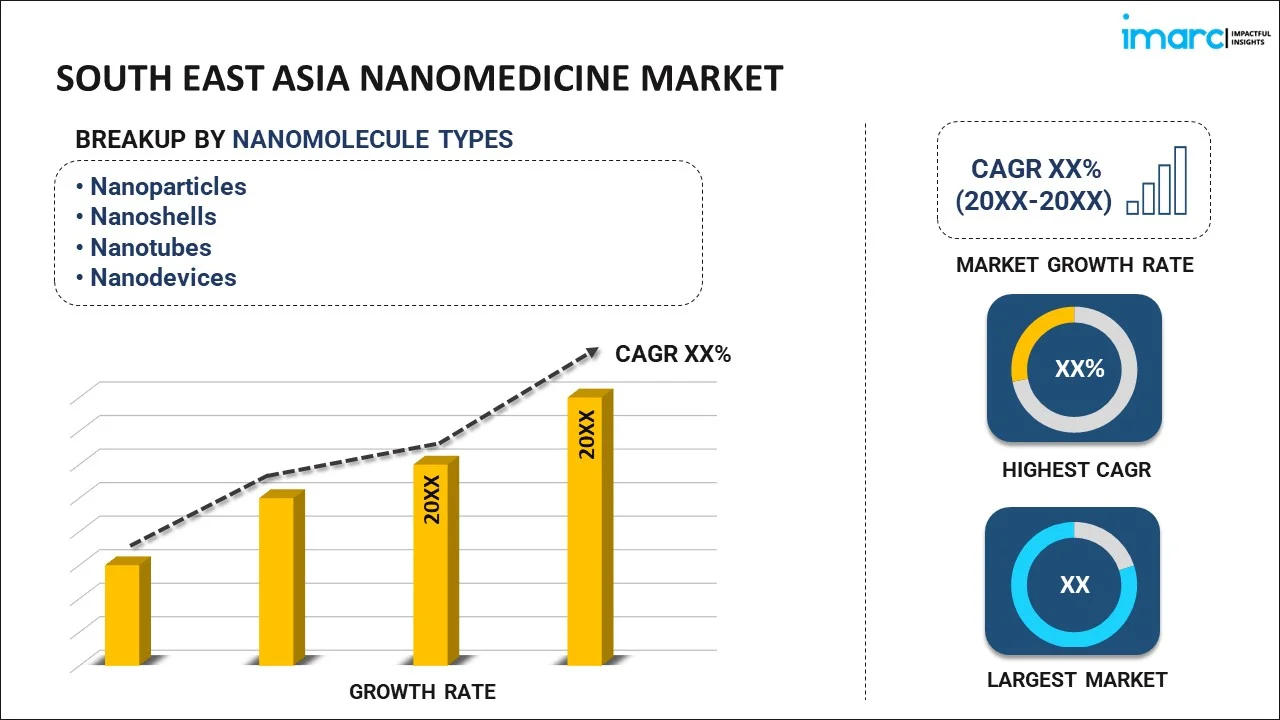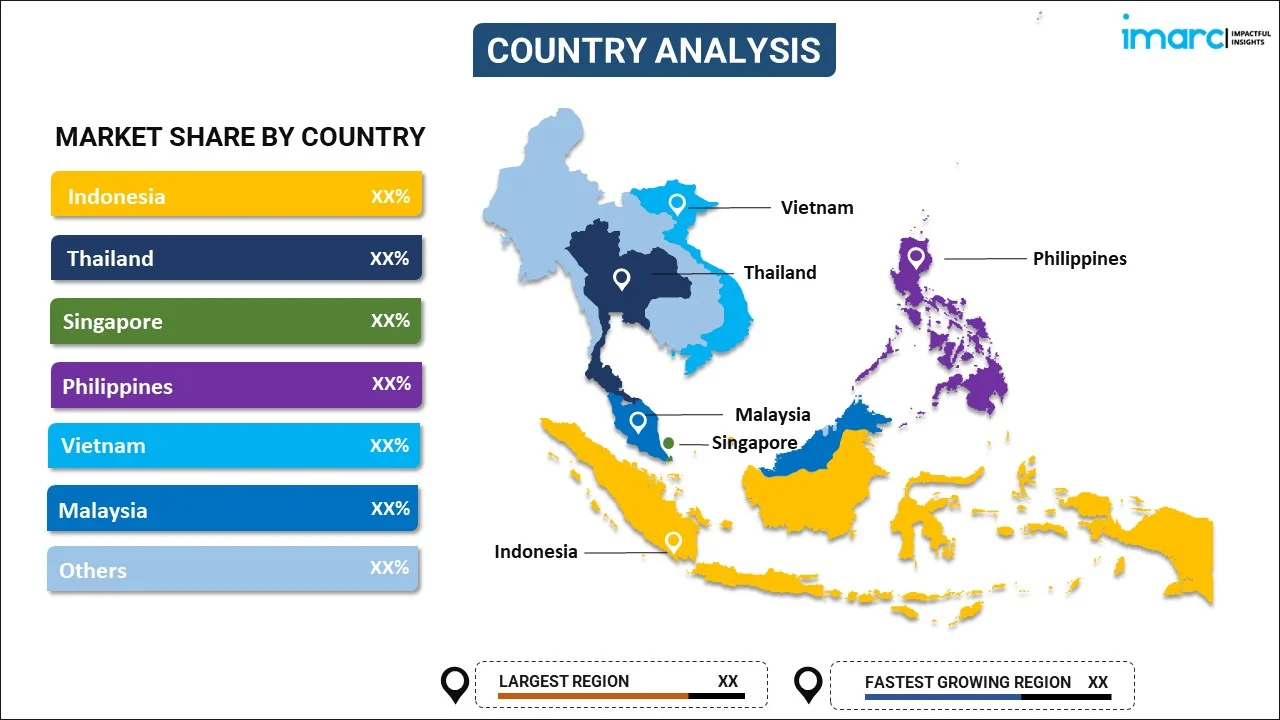
South East Asia Nanomedicine Market Report by Nanomolecule Type (Nanoparticles, Nanoshells, Nanotubes, Nanodevices), Product (Therapeutics, Regenerative Medicine, In-Vitro Diagnostics, In-Vivo Diagnostics, Vaccines), Application (Clinical Oncology, Infectious Diseases, Clinical Cardiology, Orthopedics, and Others), and Country 2024-2032
Market Overview:
The South East Asia nanomedicine market size is projected to exhibit a growth rate (CAGR) of 12.80% during 2024-2032. The emerging drug delivery advancements, the rising advancements in regenerative medicine, and the growing investments in research and development (R&D) efforts to create innovative nanomedicine products represent some of the key factors driving the market.
|
Report Attribute
|
Key Statistics
|
|---|---|
|
Base Year
|
2023 |
|
Forecast Years
|
2024-2032
|
|
Historical Years
|
2018-2023
|
| Market Growth Rate (2024-2032) | 12.80% |
Nanomedicine is an innovative field at the intersection of medicine and nanotechnology. It uses the unique properties of nanoparticles, typically measuring less than 100 nanometers, to transform the diagnosis, treatment, and prevention of diseases. This advanced approach offers immense promise in addressing healthcare challenges, including more targeted drug delivery, early disease detection, and personalized treatments. It can be engineered to carry drugs directly to the site of action, minimizing side effects and enhancing therapeutic effectiveness, which reduces the dosage required and enhances patient compliance, improving overall treatment outcomes. It offers remarkable opportunities for early disease detection and can be designed to detect specific biomarkers or abnormalities at the molecular level, allowing for the diagnosis of diseases such as cancer, diabetes, and infectious diseases in their earliest stages, which can lead to more successful interventions and improved patient prognoses. Additionally, nanomedicine is essential for the development of personalized medicine, which can tailor treatments to an individual's genetic makeup and specific disease characteristics, allowing healthcare providers to optimize therapeutic outcomes. Nanoparticles can also carry genetic material or other therapeutic agents to target cells, offering a level of precision that was previously unimaginable. At present, nanomedicine is applied widely in tissue engineering, regenerative medicine, and the development of artificial organs.
South East Asia Nanomedicine Market Trends:
The market is primarily driven by emerging drug delivery advancements. Nanomedicine has opened new avenues for drug delivery to compress drugs, allowing for controlled release and prolonged therapeutic effects, which improves the bioavailability of drugs, reduces side effects, and enhances patient compliance. As a result, pharmaceutical companies are investing in nanotechnology to develop innovative drug delivery systems. Moreover, the growing investment in the nanomedicine sector is attracting substantial investments from the public and private sectors, allowing research institutions, pharmaceutical companies, and venture capitalists to contribute to the market growth. These investments are driving research and development (R&D) efforts, leading to the creation of innovative nanomedicine products. Besides this, governments are recognizing the importance of nanomedicine and are establishing guidelines to ensure the safety and efficacy of nanomedical products, which is improving the confidence among stakeholders and accelerating market growth. Along with this, the growth of nanomedicine paved the way for personalized therapies by tailoring treatments to an individual's genetic makeup and specific disease characteristics, which is transforming the way diseases, such as cancer, are approached where personalized treatment plans are important for better outcomes, thus propelling the market growth. Furthermore, the growing advancements in regenerative medicine, with nanoscale scaffolds and materials promoting tissue regeneration and repair, offer hope for patients with conditions such as damaged organs or tissues, creating a positive market outlook.
South East Asia Nanomedicine Market Segmentation:
IMARC Group provides an analysis of the key trends in each segment of the market, along with forecasts at the regional and country levels for 2024-2032. Our report has categorized the market based on nanomolecule type, product, and application.
Nanomolecule Type Insights:

- Nanoparticles
- Metal and Metal Oxide Nanoparticles
- Liposomes
- Polymers and Polymer Drug Conjugates
- Hydrogel Nanoparticles
- Dendrimers
- Inorganic Nanoparticles
- Nanoshells
- Nanotubes
- Nanodevices
The report has provided a detailed breakup and analysis of the market based on the nanomolecule type. This includes nanoparticles (metal and metal oxide nanoparticles, liposomes, polymers and polymer drug conjugates, hydrogel nanoparticles, dendrimers, and inorganic nanoparticles), nanoshells, nanotubes, and nanodevices.
Product Insights:
- Therapeutics
- Regenerative Medicine
- In-Vitro Diagnostics
- In-Vivo Diagnostics
- Vaccines
A detailed breakup and analysis of the market based on the product have also been provided in the report. This includes therapeutics, regenerative medicine, in-vitro diagnostics, in-vivo diagnostics, and vaccines.
Application Insights:
- Clinical Oncology
- Infectious Diseases
- Clinical Cardiology
- Orthopedics
- Others
The report has provided a detailed breakup and analysis of the market based on the application. This includes clinical oncology, infectious diseases, clinical cardiology, orthopedics, and others.
Country Insights:

- Indonesia
- Thailand
- Singapore
- Philippines
- Vietnam
- Malaysia
- Others
The report has also provided a comprehensive analysis of all the major regional markets, which include Indonesia, Thailand, Singapore, Philippines, Vietnam, Malaysia, and Others.
Competitive Landscape:
The market research report has also provided a comprehensive analysis of the competitive landscape. Competitive analysis such as market structure, key player positioning, top winning strategies, competitive dashboard, and company evaluation quadrant has been covered in the report. Also, detailed profiles of all major companies have been provided.
South East Asia Nanomedicine Market Report Coverage:
| Report Features | Details |
|---|---|
| Base Year of the Analysis | 2023 |
| Historical Period | 2018-2023 |
| Forecast Period | 2024-2032 |
| Units | US$ Million |
| Scope of the Report | Exploration of Historical and Forecast Trends, Industry Catalysts and Challenges, Segment-Wise Historical and Predictive Market Assessment:
|
| Nanomolecule Types Covered |
|
| Products Covered | Therapeutics, Regenerative Medicine, In-Vitro Diagnostics, In-Vivo Diagnostics, Vaccines |
| Applications Covered | Clinical Oncology, Infectious Diseases, Clinical Cardiology, Orthopedics, Others |
| Countries Covered | Indonesia, Thailand, Singapore, Philippines, Vietnam, Malaysia, Others |
| Customization Scope | 10% Free Customization |
| Report Price and Purchase Option | Single User License: US$ 3699 Five User License: US$ 4699 Corporate License: US$ 5699 |
| Post-Sale Analyst Support | 10-12 Weeks |
| Delivery Format | PDF and Excel through Email (We can also provide the editable version of the report in PPT/Word format on special request) |
Key Questions Answered in This Report:
- How has the South East Asia nanomedicine market performed so far and how will it perform in the coming years?
- What has the impact of COVID-19 on the South East Asia nanomedicine market?
- What is the breakup of the South East Asia nanomedicine market on the basis of nanomolecule type?
- What is the breakup of the South East Asia nanomedicine market on the basis of product?
- What is the breakup of the South East Asia nanomedicine market on the basis of application?
- What are the various stages in the value chain of the South East Asia nanomedicine market?
- What are the key driving factors and challenges in South East Asia nanomedicine?
- What is the structure of the South East Asia nanomedicine market and who are the key players?
- What is the degree of competition in the South East Asia nanomedicine market?
Key Benefits for Stakeholders:
- IMARC’s industry report offers a comprehensive quantitative analysis of various market segments, historical and current market trends, market forecasts, and dynamics of the South East Asia nanomedicine market from 2018-2032.
- The research report provides the latest information on the market drivers, challenges, and opportunities in the South East Asia nanomedicine market.
- Porter's five forces analysis assist stakeholders in assessing the impact of new entrants, competitive rivalry, supplier power, buyer power, and the threat of substitution. It helps stakeholders to analyze the level of competition within the South East Asia nanomedicine industry and its attractiveness.
- A competitive landscape allows stakeholders to understand their competitive environment and provides an insight into the current positions of key players in the market.
Need more help?
- Speak to our experienced analysts for insights on the current market scenarios.
- Include additional segments and countries to customize the report as per your requirement.
- Gain an unparalleled competitive advantage in your domain by understanding how to utilize the report and positively impacting your operations and revenue.
- For further assistance, please connect with our analysts.
 Inquire Before Buying
Inquire Before Buying
 Speak to an Analyst
Speak to an Analyst
 Request Brochure
Request Brochure
 Request Customization
Request Customization




.webp)




.webp)












